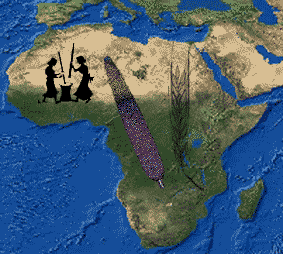|

|
 |

The Fifth International Workshop for African Archaeobotany will
be held 2-5 July, 2006
at the Institute of Archaeology,
University College London. For scheduled papers and absracts select days below.
|
The Fifth International Workshop for African Archaeobotany will
be held 2-5 July, 2006 |
|
|
Monday, 3 July, 2006 Session: Gathered resources: foragers, wood fuels and the environmental impac
Subsistence strategies in the Early and Middle Holocene in Dakhleh Oasis, Egypt
Ursula Thanheiser VIAS-Archaeobotany, Vienna University
Dakhleh is the largest oasis of the Egyptian Western Desert. It lies half-way between Luxor and the Libyan frontier and is therefore located in what is now the driest part of the eastern Sahara with less than 5 mm annual precipitation. The modern oasis is some 80 km long and about 25 km wide. It sits beneath a 300 m high escarpment and is surrounded by the sand and stone wastes of the eastern Sahara. The palaeo-oasis, however, was much larger, extending at least 15 km to the east, south and west. The palaeo-oasis has been inhabited since the mid-Pleistocene but continuously only since about 3500 B.C. During the early and middle Holocene the area witnessed extensive human activity resulting in some 200 sites. Based on intensive archaeological work by Mary McDonald during the last two decades, settlement history of this period can be divided into three more or less consecutive cultural units – Masara, Bashendi, Sheikh Muftah – distinguishable by site location, architecture, artefact assemblages, and biological remains. During the early and middle Holocene Africa witnessed several pluvial and arid phases. The general trend, however, was a shift towards arid conditions which coincided with a change in vegetation affecting the subsistence strategies of the local population. For the reconstruction of environment, availability and utilisation of resources two archaeobotanical methods were combined: analysis of charcoal and macro-remains. Unfortunately, pollen analysis, otherwise a powerful tool for the reconstruction of palaeo-environments, proved impossible, as no pollen is preserved; the same applies to phytoliths. The recovered archaeobotanical remains reflect the changing environment and human response to continuous aridification. While in Masara times subsistence strategies were based on collecting small seeded dicotyledons, the emphasis in Bashendi times was on wild cereals. Hardly any plant remains were recovered from Sheikh Muftah sites which might reflect a special purpose of the sites as possible meat processing areas. From the Old Kingdom onwards the effects of aridification were compensated by irrigation and Dakhleh Oasis features all the cultivated plants known from the Nile Valley.
... return to Monday schedule Tuesday 4 July . . . Wednesday, 5 July, 2006 ....... |
|
Send mail to d.fuller@ucl.ac.uk with questions or
comments about this web site.
|